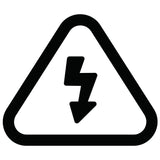Your Cart Is Our Priority
Explore our store to see what our products and resources can do for you.

Author: Christian Attlesey
Read Time: 3-5 minutes
Golf cart batteries can be a significant (albeit worthwhile) investment for your golf cart.
On the low end, you can spend anywhere from $800-$1000; on the high end, you can pay close to $6000. With a price tag like that, you must ensure you have all the necessary information to put your hard-earned money in the right spot.
This article will cover all the essential details you need to be aware of when purchasing new batteries for your golf cart. Let's dig in!

Three types of batteries are commonly used in golf carts: Deep-cycle lead-acid, AGM, and lithium-ion, with the most popular being lead-acid and lithium.
Lead-acid batteries were the standard battery in golf carts coming off the factory floor, but now all new golf cart models have lithium.
Lithium has many advantages over traditional lead-acid golf cart batteries that we will explore below.

As with everything else related to golf cart parts and accessories, golf cart batteries range in price depending on the type, size, and brand of battery you choose.
As a quick rule of thumb, deep-flooded lead acid batteries will have less upfront cost but a higher lifetime cost. On the other hand, lithium golf cart batteries will have a higher upfront cost but less total lifetime cost. Here is a quick reference of what typical golf cart batteries will cost you:
*Please note these prices are averages*

There are a few critical steps to keeping your golf cart's batteries in tip-top shape. They relate to charging, cleaning, and watering.

The biggest name in golf cart batteries is Trojan®. They have been around for a while and have made a name for themselves in lead-acid golf cart batteries.
Although Trojan® is exceptionally well known, plenty of other battery companies are starting to make a name for themselves in the lithium-ion space. UNO®, Dakota, and Roypow are some of the most popular lithium-ion golf cart battery manufacturers with a reputation for quality and excellent customer service.


Each golf cart will have a motor and controller calibrated to a specific voltage. The most common golf carts operate on either 36 or 48 volts, with a few 72-volt golf carts on the road.
As a result, when purchasing new golf cart batteries, you must ensure that the batteries you buy can provide your cart with the correct voltage. Here is a list of the standard battery setups on 36 and 48-volt carts.

On average, golf carts can fit six to eight batteries inside their battery compartment.
However, as stated in the question above, golf carts have a pre-determined voltage setup, and their battery compartments are built around their factory battery configuration.
Regarding lithium batteries, you can typically fit one to three batteries in a golf cart.

Most reputable golf cart battery manufacturers will provide a warranty with their products. The warranties are typically total replacement, pro-rated, or a combination of both.
Here is a look at some p golf cart battery manufacturers and their corresponding warranties.

Under everyday use, you should expect to see a lifespan of 3-4 years with lead-acid batteries and 10+ years with lithium batteries.
A multiplicity of factors impact a golf cart battery's performance life, so to maximize your golf cart's battery(ies) performance, make sure you perform its regularly scheduled maintenance and use it under routine operating procedures.

Lead-acid golf cart batteries: Although they may seem completely harmless, they pose a threat if you don't treat them properly.
Lead-acid batteries release hydrogen gas when they are charged. Hydrogen gas is highly flammable at small concentrations, so it is best practice to charge your battery in an open area with plenty of ventilation.
You must also regularly check the water levels of your batteries and perform their regularly scheduled maintenance. To keep you and your golf cart safe, make sure you:
Lithium golf cart batteries: A few years back, lithium batteries made the news for causing laptops and cell phones to burst into flames.
Thankfully, that was a while back, and lithium technology has made leaps and bounds regarding safety.
Without getting into much detail, the old lithium batteries were manufactured with lithium and cobalt. This combination was an early lithium technology and the culprit that caused batteries to overheat.
On the other hand, new lithium batteries are manufactured with lithium iron phosphate (LiFePO4). The chemical structure of these batteries makes them virtually non-combustible, so there is nothing to worry about with lithium golf cart batteries. It is still best practice to follow the above guidelines when charging lithium-ion golf cart batteries.
Hopefully, at this point, you have a much deeper understanding of golf cart batteries and the important factors you need to consider when looking to get yours replaced. If you still have further questions, drop them in the comments below, or feel free to reach out to us directly.
Want to know more about batteries? Check out our another one of our battery articles covering golf cart battery FAQ's!

...You probably know him as the humorous & relatable host of our YouTube channel!
Prior to taking on marketing, however, Christian honed his industry knowledge as our Customer Service Manager. Fast-forward to present day: it’s his mission to deliver the best and most current products, resources, and overall expertise to Golf Cart owners everywhere.
Explore our store to see what our products and resources can do for you.

Comments
Leave a comment